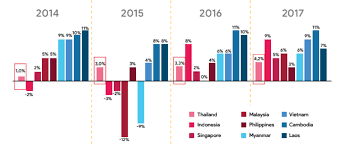

Thailand, officially the Kingdom of Thailand, is the second largest economy in Southeast Asia. The country has a high level of human development and is considered a newly industrialized economy. Thailand was a constitutional monarchy and a parliamentary democracy, however the military coup in 2014 established a de-facto military dictatorship. During the military government, namely the Pro-junta period, the country experienced many changes, both on political and economic aspects.
Over the past years, Thailand has made significant progress in economic and social development, it moved from a low income country to an upper income one in less than a generation. From 2008 to 2017 Thailand GDP and export value grew at 3.2% and 3.3% respectively. However, as a consequence of political instability between 2013 and 2014 Thai GDP grew only 1%. In 2014 the military coup took place and the country’s economy gradually recovered. During the 4 year of the Pro-Junta period Thai GDP grew at an average of 3% year on year, while merchandise exports remained weak due to their sensitivity to the global economy.
Thailand experienced an impressive economic growth in the past decade. Even in 2015, while most ASEAN countries suffered negative economic growth due to uncertainties in the global economy, Thailand GDP growth remained constant. However, in recent years other ASEAN countries have performed better. In fact, in the four year of the military government, Thailand’s economic growth was stable at just 3%, a figure lower than the neighbouring countries. The government new wage policy helped the country’s economic growth to remain stable, however it resulted in a loss of competitiveness against other neighbouring countries.
Despite the dynamic, Thailand’s Foreign Direct Investment grew with a CAGR of 4% over the past 10 years. During the Pro-Junta period, foreign direct investment in the country varied substantially. In 2016, due to the increase in wages and poor Thai technology industry, FDI experienced a huge drop of 69%. However, in 2017 foreign direct investments have largely recovered, with the country investing more in advanced technologies and innovation. Moreover, the Eastern Economic Corridor (EEC) Act, which offers benefit to investors in the region in the form of tax subsidies and land ownership, is attracting more and more investors.
Our latest report, What You Need to Know Before Investing in Thailand, shows that over the past decade Thailand’s government has aggressively invested in Mega projects. These investments have largely increased the ratio of government debt to GDP. From 2008 to 2017, government debt grew at a staggering pace of 10% CAGR. During the Pro-Junta period in particular, the ratio reached approximately 50%.
Thailand has undoubtedly experienced many political and economic issues in the past years. The recent political elections have brought significant changes in Thai political situation, and have raised various concerns for the business world. Following the recent election, the new government could bring important implications for businesses, such as increased taxes or public deficits.
To get more information about Thai elections and the business implications it could bring for Thai’s business environment download: ’’What you need to know before investing in Thailand - A short term analysis on Thai business landscape post-election 2019’’.

Digital Lending in Southeast Asia: Current Trends and Future Outlook
Digital lending in Southeast Asia (SEA) has been on an upward trajectory, significantly enhancing financial access for both individuals and businesses. The region's high internet and mobile penetration rates have facilitated this growth, enabling more people to access financial services conveniently. Governments across SEA are actively promoting digital lending as a means to improve financial inclusion, particularly for the underbanked and unbanked populations. For instance, digital lenders in countries like Indonesia and the Philippines have capitalized on the surge in internet usage to offer innovative lending solutions.

The Latest Trends and Developments in SEA’s Digital Payments Landscape
The adoption of digital payments in Southeast Asia (SEA) has accelerated, driven by technological advancements, government initiatives, and changing consumer behaviors. It has evolved from simple online transactions to sophisticated financial ecosystems that include various payment methods such as mobile wallets, QR code payments, and Buy Now Pay Later (BNPL) options.

Navigating the Digital Era: Future Jobs and Skills in the Age of Digitalization
The job market's transformation driven by digitalization highlights the need to understand emerging trends and acquire essential skills for thriving.

Navigating Key Challenges in Southeast Asia’s EV Market
Southeast Asia (SEA) finds itself at a crucial juncture in the journey towards electric vehicle (EV) production and adoption as the world transitions towards sustainable transportation solutions. The region has several significant keys for developing the EV industry, such as Indonesia's nickel supply and Thailand's EV manufacturing potential. However, the ASEAN EV industry faces many challenges and threats that must be overcome to ensure success in the region.